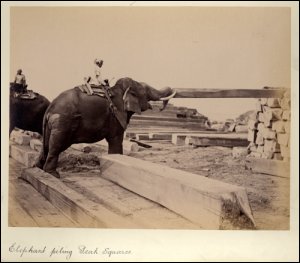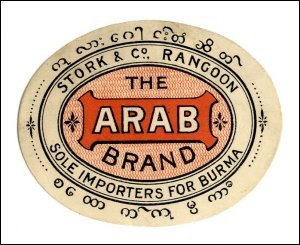Myanmar (Burma)
Collection: Edmiston & Mitchells (GUAS Ref: UGD 169)
In the 19th century Scottish firms were importing timber from as far a field as America, the Baltic, Caribbean, and Asia for use in buildings, for furniture manufacture and for shipbuilding. This image is from a photograph album of MacGregor’s sawmill in Burma in the collection of Edmiston & Mitchells, timber brokers; Glasgow.
The album has photographs of elephants moving teak logs and squared timbers, bathing in the river, and suffering the indignity (and fear) of being hoisted on board ships.
(GUAS Ref: UGD 169/17/3/16. Copyright reserved.)
 View larger image For further information on the Edmiston & Mitchells archive, please see the online catalogue.
View larger image For further information on the Edmiston & Mitchells archive, please see the online catalogue.
Collection: Alexander Melvin & Co (GUAS Ref: AM)
Scottish brewers ventured into the export market in the 18th century shipping barrels of Scotch Ales to America, the Netherlands and the West Indies. By 1900, when the export market was at its height, a third of UK beer exports came from Scotland. In countries where cholera and dysentery were rife, it was safer to drink beer than the local water.
This page is from an export order book for Alexander Melvin & Co, brewers in Edinburgh, with an order for Rangoon, placed on 21st September 1893. Although a relatively small firm, Melvin’s had an extensive export market sending hogsheads of ales to destinations such as India, Guantanamo, South Africa, Australia and Burma.
(GUAS Ref: AM 7/2/1. Copyright reserved.) For further information on the Alexander Melvin & Co archive, please see the online catalogue.
Collection: George Younger & Son Ltd (GUAS Ref: GY)
By the 1860s Scottish brewers, in common with English brewers, had begun to brew ales especially for tropical climates. These extra-hopped pale ales were able to stand the long sea journeys without deteriorating, which was a particular problem with beer in barrels. The light taste of these "Export" or "India Pale Ales" also proved popular with customers in Britain. The demand for lighter, sparkling beers led brewers in the 1880s to extend their product ranges to include lager.
Labels for bottled beers had to be eye-catching to make them distinctive from those of rival brewers, especially for markets where the locals could not read English. This label is for the Arab Brand of George Younger, brewers and maltsters, Alloa and was used for the Burmese export market.

View larger image (GUAS Ref: GY. Copyright reserved.) For further information on the George Younger & Sons Ltd archive, please see the online catalogue.




